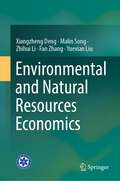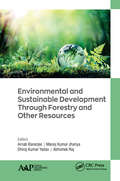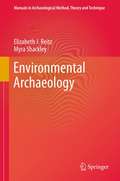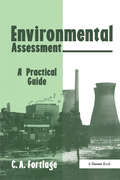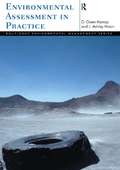- Table View
- List View
Environmental and Microbial Relationships (The Mycota #IV)
by Irina S. Druzhinina Christian P. KubicekThis volume provides insights into current research on fungal populations, communities and their interactions with other organisms. It focuses on fungal responses to the physical environment; interactions with bacteria, other fungi, invertebrates and plants; the role of fungi in ecosystem processes such as decomposition and nutrient cycling; and aspects of biogeography and conservation.Since the publication of the second edition of Volume IV in 2007, the massive use of “omics” methods has revolutionized our understanding of fungal lifestyles. Highlighting these advances, the third edition has been completely updated and revised. Several chapters deal with various applications of genomics and transcriptomics in biological pest control, as well as interactions with other living systems. This is an invaluable source of information both for scientists who wish to update their knowledge of current advances and for graduate students interested in obtaining a comprehensive introduction to this field of research.
Environmental and Microbial Relationships (The Mycota #4)
by Christian P. Kubicek Irina S. DruzhininaThis volume provides insight into current research on fungal populations and communities. It focuses on fungal responses to the physical environment, interactions with other fungi, microorganisms and invertebrates, the role of fungi in ecosystem processes such as decomposition and nutrient cycling, and aspects of biogeography and conservation. The second edition has been completely updated and revised to accommodate the introduction of molecular methods, and the flood of new findings since then.
Environmental and Natural Resources Economics
by Xiangzheng Deng Malin Song Zhihui Li Fan Zhang Yuexian LiuThis book aims to integrate multiple disciplinary such as management, economics, and geography from the perspective of resource science and also to strengthen research on resource management to promote sustainability in natural resources. It established clear definition of natural resources and in-depth exploration of main fields such as water resources, land resources, and agricultural resources. Classic methods of economics are applied to solve the problems of resource consumption, environmental pollution, and climate change in modern society. On the basis of classical economics, the disciplinary system of environmental and natural resources is further developed. It is a helpful reference for readers to further study natural resources and environmental economics.
Environmental and Natural Resources Engineering: Water Resources And Natural Control Processes (Handbook of Environmental Engineering #19)
by Lawrence K. Wang Mu-Hao Sung Wang Yung-Tse Hung Nazih K. ShammasThis volume has been designed to serve as a natural resources engineering reference book as well as a supplemental textbook. This volume is part of the Handbook of Environmental Engineering series, an incredible collection of methodologies that study the effects of resources and wastes in their three basic forms: gas, solid, and liquid. It complements two other books in the series including "Natural Resources and Control Processes" and "Advances in Natural Resources Management". Together they serve as a basis for advanced study or specialized investigation of the theory and analysis of various natural resources systems.This book covers many aspects of resources conservation, treatment, recycling, and education including agricultural, industrial, municipal and natural sources. The purpose of this book is to thoroughly prepare the reader for understanding the available resources, protection, treatment and control methods, such as bee protection, water reclamation, environmental conservation, biological and natural processes, endocrine disruptor removal, thermal pollution control, thermal energy reuse, lake restoration, industrial waste treatment, agricultural waste treatment, pest and vector control, and environmental engineering education. The chapters provide information on some of the most innovative and ground-breaking advances in environmental and natural resources engineering from a panel of esteemed experts.
Environmental and Resources Geochemistry of Earth System: Mass Transfer Mechanism, Geochemical Cycle and the Influence of Human Activity
by Naotatsu ShikazonoThe Earth system consists of subsystems that include the atmosphere, hydrosphere (water), geosphere (rocks, minerals), biosphere, and humans. In order to understand these subsystems and their interactions, it is essential to clarify the mass transfer mechanism, geochemical cycle, and influence of human activity on the natural environment. This book presents fundamental theories (thermodynamics, kinetics, mass balance model, coupling models such as the kinetics-fluid flow model, the box model, and others) concerning mechanisms in weathering, formation of hydrothermal ore deposits, hydrothermal alteration, formation of groundwater quality, and the seawater system. The interaction between fluids (atmosphere, water) and solid phases (rocks, minerals) occurs both in low-temperature and also in high-temperature systems. This book considers the complex low-temperature cycle with the high-temperature cycle, a combination that has not been dealt with in previous books concerning Earth systems. Humanity is a small part of the biosphere; however, human activities greatly influence Earth’s surface environments (atmosphere, hydrosphere, biosphere, soils, rocks). Thus, the influences of humans on other subsystems, particularly mass transfer in the deep underground geologic environment composed of host rocks and groundwater, are discussed in relation to high-level nuclear waste geologic disposal and CO2 underground sequestration—topics that have not been included in other books on environmental science.
Environmental and Social-economic Impacts of Sewage Sludge Treatment: The Evidence of Beijing (SpringerBriefs in Economics)
by Guofeng ZhangThis book presents an experimental simulation of sewage treatment, which is designed to evaluate the environmental and social-economic impacts of integrated sewage treatment policies. The author puts forward a comprehensive linear optimization simulation model that takes the environmental, energy and economic systems into consideration. Beijing was selected as a typical Chinese city for the purposes of simulation, and the comprehensive model employed realistically reflects the specific and unique characteristics of Beijing’s social economy and environmental status. Given the importance of sewage treatment and the accurate assessment of its impacts, the book will be of interest to researchers and scholars of environmental economics.
Environmental and Sustainable Development Through Forestry and Other Resources
by Arnab Banerjee Manoj Kumar Jhariya Dhiraj Kumar Yadav Abhishek RajThis book looks at using forestry and several other innovative measures to facilitate environmental sustainability, covering an important selection of research that focuses on scientific applications and trends. Chapters discuss such diverse topics as using agroforestry for resource management, employing legumes in agroforestry, livestock management for climate change mitigation, introducing higher plants for air pollution mitigation in urban industrial areas, the uses and benefits of sludge, technological assessment of sewage treatment plants, and much more. This book will be a helpful and informative reference for those in the disciplines of forestry, agriculture, ecology, and environmental science and will also be a pathway to addressing new concepts for a sustainable world.
Environmental and Sustainable Development Through Forestry and Other Resources
by Arnab Banerjee Manoj Kumar Jhariya Dhiraj Kumar Yadav Abhishek RajThis book looks at using forestry and several other innovative measures to facilitate environmental sustainability, covering an important selection of research that focuses on scientific applications and trends. Chapters discuss such diverse topics as using agroforestry for resource management, employing legumes in agroforestry, livestock management for climate change mitigation, introducing higher plants for air pollution mitigation in urban industrial areas, the uses and benefits of sludge, technological assessment of sewage treatment plants, and much more. This book will be a helpful and informative reference for those in the disciplines of forestry, agriculture, ecology, and environmental science and will also be a pathway to addressing new concepts for a sustainable world.
Environmental Applications of Instrumental Chemical Analysis
by Mahmood BarbootiThis book is a comprehensive review of the instrumental analytical methods and their use in environmental monitoring site assessment and remediation follow-up operations.The increased concern about environmental issues such as water pollution, air pollution, accumulation of pollutants in food, global climate change, and effective remediation proces
Environmental Applications of Mechanics and Computer Science: Proceedings of CISM 30th Anniversary Conference Udine, May 29, 1999 (CISM International Centre for Mechanical Sciences #409)
by Giovanni BianchiIn 1999 the International Centre for Mechanical Sciences celebrates thirty years of activity. For this celebration CISM has organized a series of courses and meetings on environmental problems, one of the leading subjects today of theoretical and applied research all over the world. The results obtained directly influence our daily life, particularly in applications for protection from pollution and natural hazards. The most significant of the events was the Conference on "Environmental Applications of Mechanics and Computer Science”, where prominent scientists in the field present significant examples of the scientific approach to large scale phenomena involved in environmental problems.
Environmental Applications of Nucleic Acid Amplification Technology
by Gary A. ToranzosFrom the PrefaceAntibody techniques have allowed us to study microorganisms in situ. However, until recently all methodology lacked the sensitivity necessary for environmental work where microorganisms are in most cases present at very low concentrations or where microbial ecosystems contain a myriad of different organisms. Gene probes have been used successfully for a variety of samples, but this method was still not sensitive enough. The next logical step was the application of the recently developed DNA amplification technique known as the polymerase chain reaction, or PCR. Since then, many laboratories around the world have adopted PCR for environmental work. Samples obtained from soils, water and air are enormously complex because they are unknown mixtures of DNA and other compounds. Thus, procedures for target DNA amplification from the environment require special attention. The PCR has allowed us to go beyond the need for culturing prior to analysis of microbial communities. It has been shown that even microorganisms that can be routinely grown in the laboratory undergo some physiological changes when exposed to the environment. One of these changes (first observed by R. Colwell and colleagues) is known as the viable-but-non-culturable state, and seems to be a common occurrence. Thus, the use of culture techniques paint only part of the picture in terms of microbial behavior under environmental conditions. The ability to amplify nucleic acids by the PCR has brought about a myriad of very ingenious modifications to the technique that can then be used to study complex ecosystems. The manner in which the PCR can be modified is only limited by the need and/or the imagination of the researcher. The first manual dedicated specifically to the analysis (by PCR) of environmental samples, Environmental Applications of Nucleic Acid Amplification Techniques presents state of the art methodology for the detection of microorganisms in soil, water, air samples, as well as the amplification of nucleic acids from fossil samples. The manual gives step-by-step procedures for the analysis of these samples. Although several publications have addressed the use of Polymerase Chain Reaction technique, very few of them have been directed toward the application of this technique to environmental samples. This book fills this gap in the literature.
Environmental Applications of Nucleic Acid Amplification Technology
by Gary A. ToranzosFrom the PrefaceAntibody techniques have allowed us to study microorganisms in situ. However, until recently all methodology lacked the sensitivity necessary for environmental work where microorganisms are in most cases present at very low concentrations or where microbial ecosystems contain a myriad of different organisms. Gene probes have been used successfully for a variety of samples, but this method was still not sensitive enough. The next logical step was the application of the recently developed DNA amplification technique known as the polymerase chain reaction, or PCR. Since then, many laboratories around the world have adopted PCR for environmental work. Samples obtained from soils, water and air are enormously complex because they are unknown mixtures of DNA and other compounds. Thus, procedures for target DNA amplification from the environment require special attention. The PCR has allowed us to go beyond the need for culturing prior to analysis of microbial communities. It has been shown that even microorganisms that can be routinely grown in the laboratory undergo some physiological changes when exposed to the environment. One of these changes (first observed by R. Colwell and colleagues) is known as the viable-but-non-culturable state, and seems to be a common occurrence. Thus, the use of culture techniques paint only part of the picture in terms of microbial behavior under environmental conditions. The ability to amplify nucleic acids by the PCR has brought about a myriad of very ingenious modifications to the technique that can then be used to study complex ecosystems. The manner in which the PCR can be modified is only limited by the need and/or the imagination of the researcher. The first manual dedicated specifically to the analysis (by PCR) of environmental samples, Environmental Applications of Nucleic Acid Amplification Techniques presents state of the art methodology for the detection of microorganisms in soil, water, air samples, as well as the amplification of nucleic acids from fossil samples. The manual gives step-by-step procedures for the analysis of these samples. Although several publications have addressed the use of Polymerase Chain Reaction technique, very few of them have been directed toward the application of this technique to environmental samples. This book fills this gap in the literature.
Environmental Archaeology (Manuals in Archaeological Method, Theory and Technique)
by Elizabeth Reitz Myra ShackleyOne of the most significant developments in archaeology in recent years is the emergence of its environmental branch: the study of humans’ interactions with their natural surroundings over long periods and of organic remains instead of the artifacts and household items generally associated with sites. With the current attention paid to human responsibility for environmental change, this innovative field is recognized by scientists, conservation and heritage managers and policymakers worldwide. In this context comes Environmental Archaeology by Elizabeth Reitz and Myra Shackley, updating the seminal 1981 text Environmental Archaeology by Myra Shackley. Rigorously detailed yet concise and accessible, this volume surveys the complex and technical field of environmental archaeology for researchers interested in the causes, consequences and potential future impact of environmental change and archaeology. Its coverage acknowledges the multiple disciplines involved in the field, expanding the possibilities for using environmental data from archaeological sites in enriching related disciplines and improving communication among them. Introductory chapters explain the processes involved in the formation of sites, introduce research designs and field methods and walk the reader through biological classifications before focusing on the various levels of biotic and abiotic materials found at sites, including: Sediments and soils. Viruses, bacteria, archaea, protists and fungi. Bryophytes and vascular plants. Wood, charcoal, stems, leaves and roots. Spores, pollen and other microbotanical remains. Arthropods, molluscs, echinoderms and vertebrates. Stable isotopes, elements and biomolecules. The updated Environmental Archaeology is a major addition to the resource library of archaeologists, environmentalists, historians, researchers, policymakers—anyone involved in studying, managing or preserving historical sites. The updated Environmental Archaeology is a major addition to the resource library of archaeologists, environmentalists, historians, researchers, policymakers—anyone involved in studying, managing, or preserving historical sites.
Environmental Aspects of Converting CW Facilities to Peaceful Purposes: Proceedings of the NATO Advanced Research Workshop on Environmental Aspects of Converting CW Facilities to Peaceful Purposes and Derivative Technologies in Modeling, Medicine and Monitoring Spiez, Switzerland April 1999 (NATO Science Partnership Subseries: 1 #37)
by Raymond R. McGuire John C. ComptonProceedings of the NATO Advanced Research Workshop, held in Spiez, Switzerland, April 1999
Environmental Aspects of Oil and Gas Production
by J. O. Robertson G. V. ChilingarOil and gas still power the bulk of our world, from automobiles and the power plants that supply electricity to our homes and businesses, to jet fuel, plastics, and many other products that enrich our lives. With the relatively recent development of hydraulic fracturing ("fracking"), multilateral, directional, and underbalanced drilling, and enhanced oil recovery, oil and gas production is more important and efficient than ever before. Along with these advancements, as with any new engineering process or technology, come challenges, many of them environmental. More than just a text that outlines the environmental challenges of oil and gas production that have always been there, such as gas migration and corrosion, this groundbreaking new volume takes on the most up-to-date processes and technologies involved in this field. Filled with dozens of case studies and examples, the authors, two of the most well-known and respected petroleum engineers in the world, have outlined all of the major environmental aspects of oil and gas production and how to navigate them, achieving a more efficient, effective, and profitable operation. This groundbreaking volume is a must-have for any petroleum engineer working in the field, and for students and faculty in petroleum engineering departments worldwide.
Environmental Aspects of Oil and Gas Production
by J. O. Robertson G. V. ChilingarOil and gas still power the bulk of our world, from automobiles and the power plants that supply electricity to our homes and businesses, to jet fuel, plastics, and many other products that enrich our lives. With the relatively recent development of hydraulic fracturing ("fracking"), multilateral, directional, and underbalanced drilling, and enhanced oil recovery, oil and gas production is more important and efficient than ever before. Along with these advancements, as with any new engineering process or technology, come challenges, many of them environmental. More than just a text that outlines the environmental challenges of oil and gas production that have always been there, such as gas migration and corrosion, this groundbreaking new volume takes on the most up-to-date processes and technologies involved in this field. Filled with dozens of case studies and examples, the authors, two of the most well-known and respected petroleum engineers in the world, have outlined all of the major environmental aspects of oil and gas production and how to navigate them, achieving a more efficient, effective, and profitable operation. This groundbreaking volume is a must-have for any petroleum engineer working in the field, and for students and faculty in petroleum engineering departments worldwide.
Environmental Aspects of Trace Elements in Coal (Energy & Environment #2)
by FariGoodarzi Dalway J. SwaineHappy he who could learn the causes of things (Virgil, Georgics 11) There is clearly a place for a book on the environmental aspects of trace elements in coal, especially with the increasing use of coal for power production. Our aim is to provide relevant background information and to update the situation regarding trace elements during beneficiation, combustion, .atmospheric deposition, leaching from wastes anti reclamation. The outcome is a balanced account of the overall situation. The initial chapter gives the rationale behind the planning of the book and puts the topics into the context of trace elements in the environment, while the final chapter summarises the subject matter and conclusions of each chapter. The choice of authors was based on their specialised knowledge. Although every effort has been made to ensure uniformity in layout, use of units, references and the like, authors have been given some latitude in expression and their styles have not been curbed. This book is intended primarily for coal scientists and technologists involved in environmental aspects of trace elements during the mining of coal, its beneficiation and usage, especially for power generation, and for regulatory bodies. It is considered to be suitable for relevant postgraduate courses. Just as it has been said that one of Bruckner's symphonies has enough melodies for a Beethoven to have written ten symphonies, so this book has several chapters that could be themes for other books.
Environmental Assessment: A Practical Guide
by C.A. FortlageEnvironmental assessment is a means of counteracting, foreseeing and controlling interference in the environment. All new major developments in Europe and North America are now subjects of scrutiny to prevent them from causing significant harmful effects to the land, sea or air. This book is an essential guide to the process, reviewing the history and background to assessment, summarizing the current legislation and providing useful advice on the skills and management techniques needed for a successful environmental assessment project. Environmental Assessment opens with a review of the US origins of the scheme, definitions and explanations of how the UK has implemented controls. This is followed by the law, rules, regulations and legislation applicable to the UK and the EC directives for the European Community. The author examines management and monitoring, setting up project teams, researching and presenting effective information, as well as calculating and analysing the potential effects of the project. Mitigating measures and alternatives are discussed, as are qualitative assessment techniques. The book has been written for architects, planners and landscape designers, who may be unfamiliar with the techniques, but who are directly involved in shaping the landscape. It would also be a valuable handbook for local planning authority councillors, environmental groups and anyone involved in sensitive development proposals. Although not written as a textbook, environmental students will discover clear jargon-free explanations of and insights into the practice of environmental assessment.
Environmental Assessment: A Practical Guide
by C.A. FortlageEnvironmental assessment is a means of counteracting, foreseeing and controlling interference in the environment. All new major developments in Europe and North America are now subjects of scrutiny to prevent them from causing significant harmful effects to the land, sea or air. This book is an essential guide to the process, reviewing the history and background to assessment, summarizing the current legislation and providing useful advice on the skills and management techniques needed for a successful environmental assessment project. Environmental Assessment opens with a review of the US origins of the scheme, definitions and explanations of how the UK has implemented controls. This is followed by the law, rules, regulations and legislation applicable to the UK and the EC directives for the European Community. The author examines management and monitoring, setting up project teams, researching and presenting effective information, as well as calculating and analysing the potential effects of the project. Mitigating measures and alternatives are discussed, as are qualitative assessment techniques. The book has been written for architects, planners and landscape designers, who may be unfamiliar with the techniques, but who are directly involved in shaping the landscape. It would also be a valuable handbook for local planning authority councillors, environmental groups and anyone involved in sensitive development proposals. Although not written as a textbook, environmental students will discover clear jargon-free explanations of and insights into the practice of environmental assessment.
Environmental Assessment and Habitat Evaluation of the Upper Great Lakes Connecting Channels (Developments in Hydrobiology #65)
by M. Munawar T. EdsallEnvironmental Assessment in Practice (Routledge Environmental Management)
by Owen Harrop Ashley NixonThis text explains what constitutes good practice in applying environmental assessment as an environmental management tool. A wide range of case studies and other student text features are employed to demonstrate how the different methods, techniques and disciplines of environmental assessment can be used. The authors address the key concepts for environmental assessment procedures: methods for using E.A.; techniques for impact prediction and evaluation; environmental risk assessment; EA consultation and participation; project management; environmental statement review and post-project analysis; and strategic environmental assessment.Worldwide case studies include: gas pipelines, hydroelectric power plants, gold mining, river crossings, waste-to-energy plants and gravel extraction in England, Scotland, Ireland, Canada, the USA, Venezuela, the Netherlands, Iceland, Zambia, Zimbabwe, South Africa and Ghana.
Environmental Assessment in Practice (Routledge Environmental Management)
by Owen Harrop Ashley NixonThis text explains what constitutes good practice in applying environmental assessment as an environmental management tool. A wide range of case studies and other student text features are employed to demonstrate how the different methods, techniques and disciplines of environmental assessment can be used. The authors address the key concepts for environmental assessment procedures: methods for using E.A.; techniques for impact prediction and evaluation; environmental risk assessment; EA consultation and participation; project management; environmental statement review and post-project analysis; and strategic environmental assessment.Worldwide case studies include: gas pipelines, hydroelectric power plants, gold mining, river crossings, waste-to-energy plants and gravel extraction in England, Scotland, Ireland, Canada, the USA, Venezuela, the Netherlands, Iceland, Zambia, Zimbabwe, South Africa and Ghana.
Environmental Assessment of Lightweight Electric Vehicles (Sustainable Production, Life Cycle Engineering and Management)
by Patricia EgedeThis monograph adresses the challenge of the environmental assessment of leightweight electric vehicles. It poses the question whether the use of lightweight materials in electric vehicles can reduce the vehicles’ environmental impact and compares the environmental performance of a lightweight electric vehicle (LEV) to other types of vehicles. The topical approach focuses on methods from life cycle assessment (LCA), and the book concludes with a comprehensive concept on the environmental assessment of LEVs. The target audience primarily comprises LCA practitioners from research institutes and industry, but it may also be beneficial for graduate students specializing in the field of environmental assessment.
Environmental Assessment of Patagonia's Water Resources (Environmental Earth Sciences)
by Américo Iadran Torres Verena Agustina CampodonicoThis book presents contributions devoted to the hydrogeochemical characterization of aquatic environments of Patagonia, including those of Ushuaia city, known as "The southernmost city in the world". Patagonia (between 39° and 55° S) is located in southern South America. Eight main river systems pour their waters into the SW Atlantic Ocean. Rivers, with their headwaters mainly located in the Andes, supply dissolved and particulate matter to the coastal zone, as well as nutrients, which benefit biological communities. Besides, freshwater in this region with little anthropogenic impact supports human life and a high wildlife biodiversity. Unfortunately, the recent increase in human activities, such as the use of fertilizers, wastewater discharges, extensive deforestation and dam construction, is affecting the quality and quantity of water resources. The book is of interest for researchers, professors and government agencies that decide on water resources management policies.
Environmental Assessment of Recycled Waste (Environmental Footprints and Eco-design of Products and Processes)
by Subramanian Senthilkannan MuthuThis book with its six interesting chapters highlights the environmental assessment of recycled waste. Waste Management is one of the main topics of concern for an organization and a nation. Out of different destinations at the end of life for a product, Recycling is the need of the hour and is an inevitable destination. Literally all wastes (be it- postindustrial or post-consumer states) if they cannot be reused, have to be recycled. Recycled products are in demand today and we are seeing many recycled alternatives for almost all industrial sectors. One of the million-dollar question to answer in terms of recycling and recycled products is- whether the recycled products are environmentally sustainable than the virgin alternatives? It is highly imperative to ascertain the environmental footprints of recycled products and recycling processes and also find out the best possible ways to further improve the environmental benefits of such recycled products and recycling processes.


